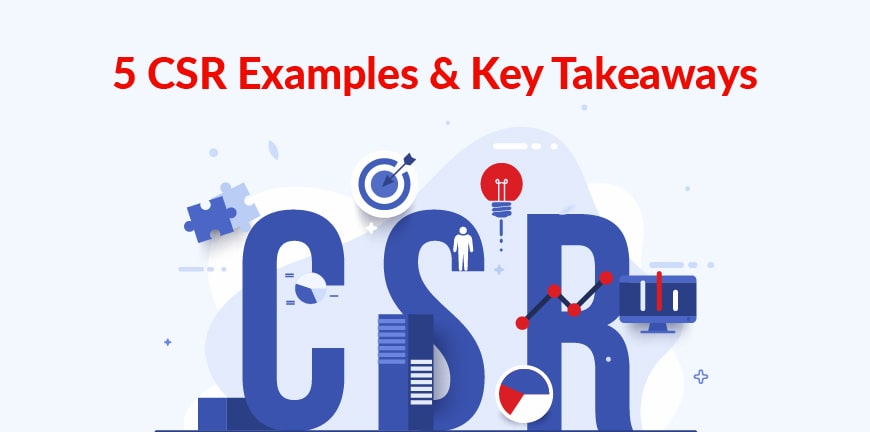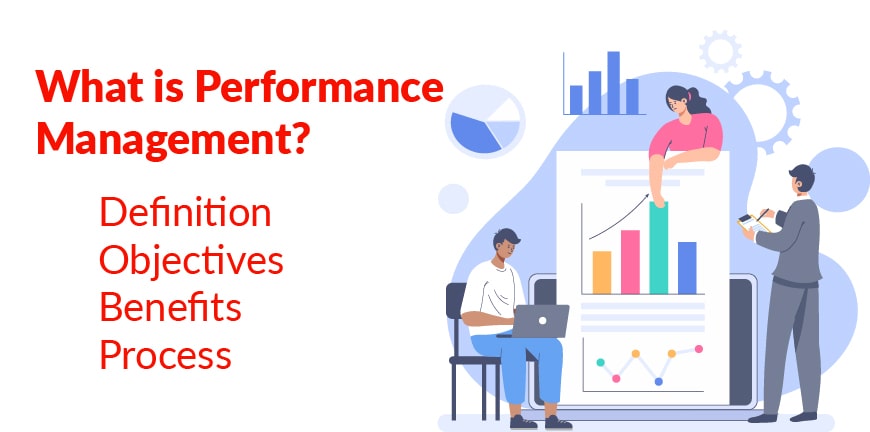
5 Examples of Impactful CSR and What We can Learn from Them
26/12/2023
What are the Ways of Outsourcing Cost Savings?
28/12/2023- What Is the Definition of Performance Management?
- Objectives of Performance Management
- Importance and Benefits of Performance Management
- Performance Management Process
- Difference Between Performance Management and Performance Appraisal
- Features of a Performance Management System
- Benefits of a Performance Management System (PMS) in HR
- You Need a Performance Management Partner
- FAQs
A greater truth has perhaps never been told in the corporate world. The success of a business is heavily reliant on dedicated, high-performing employees. But to ensure that employees perform at their peak, it is necessary to decide on what paths they should take and what paths they shouldn’t. And to let them know what paths to take, it is essential to keep score. That is what performance management is all about.
What Is the Definition of Performance Management?
The process of continuous communication and feedback between a manager and an employee, with the purpose of aligning the individual goals with the strategic goals of the business, achieving better productivity and eventually better business outcomes is referred to as performance management.
To measure the results with regard to short-term and long-term goals and important milestones, performance management uses performance management software. One of the aspects of performance management that most people are familiar with, and what brings joy to an individual if the outcome is positive, is performance appraisal.
Objectives of Performance Management
Performance management must be useful both from a business perspective and from the perspective of employees and managers. Let us look at the objectives from these three different angles.
Business
To drive growth in terms of revenue and customer satisfaction by reducing turnaround times and increasing productivity levels
To improve the reputation of the business by improving the quality of services provided to the customers and by improving confidence with the employees by removing any doubts they may have, eventually leading to them sharing positive reviews about the company.
Employees
To provide employees a clear plan of action, which will ensure that they complete the work they need to complete on time.
To help with understanding employee needs and suggestions to improve the performance management process and their abilities to reach their goals.
Managers
To provide managers with a comprehensive understanding of every employee’s progress from day one and ensure that the task allocation is optimal.
To provide managers with an idea of the skill levels of each employee, so that they can make learning and development recommendations to HR, who can then conduct these training programs.
Importance and Benefits of Performance Management
Helps with goal setting
Performance management can help set goals that are specific, measurable, achievable, relevant and time-based. Specificity allows employees to have clarity about what they must do. The fact that they are measurable allows management to easily measure and track the progress of individual employees.
Since the goals are achievable, it makes them more realistic, and they need not be changed or redefined later. Again, relevance also means that the goals are relevant to what the employee is doing. Lastly, the fact that the goals are time-based allows employees to complete certain tasks in a certain period and focus on other strategic activities after this.
Team is more engaged
With continuous performance management, the employees are more motivated than before and there is more clarity of thought. The weekly and quarterly meetings allow managers to put forth their feedback and encourage employee feedback through surveys, which again improves their level of engagement.
Team meetings become more fruitful when employees share their strengths with their peers and request feedback on how to improve the areas identified as lacking in the performance management report.
Improves productivity levels
It is proven that continuous performance management improves the productivity levels of employees. It does so by giving employees a sense of purpose at work and a way to measure their own progress. Consequently, they complete their tasks much faster than before and can reduce the turnaround times, ensuring that the customer satisfaction also goes up at the end of the day and brand visibility and perception improve.
Establishes transparency
The fact that employees know where they stand and that the results of performance management are documented and saved for the future by HR ensures that there is a level of transparency regarding the kind of work they get, and the timelines employees are expected to work in. There is also transparency regarding the difficulty level of the work and the resources that will be provided to them.
Together, everything creates an environment of continuous improvement for each employee and confidence in the establishment too. Managers too benefit from such transparency as they have a bird’s eye view of productivity levels across their team and how to manage the employees to improve the ROI of the business.
Recognises high performers
Your high performers are hidden away unless you look for them. Thanks to quarterly and monthly performance management reviews, it is possible to unearth real talent and dedication in your company and reward them appropriately.
Once you know who your high performers are, you can then work on their strengths, fine tune them and look at ways they can build on the skills they may be lacking in. Who knows, a future leader and creative problem solver, who could lead your company onwards to greater business growth, may emerge from among them.
Performance Management Process
The performance management process is a continuous cycle, and it is generally divided into the following four phases. These phases begin with planning and end with action in each cycle. Let us now look at these steps more closely.
Planning
During this phase, the job is looked at more closely, including the skills and the competencies required to complete it. Goals are set for the job. This is then aligned with the goals of the business. In the next step of the Planning phase, the feedback from the employee who will be doing the job is taken.
Whatever suggestions they have will be incorporated and the goals will be redefined, if they need to be. In the last step, or the approval stage, the plan, with the suggestions made by the employees, is approved by the higher management.
Coaching
After the planning phase is over, it is necessary to do some coaching. There must be less of discussion on punitive measures to deal with employees whose performance is lacklustre. Instead provide constructive feedback and suggests learning resources for the employees to upskill themselves. Again, even in this phase, the management must revisit and modify, if necessary, the objectives set based on feedback from employees.
Reviewing
Now comes the actual process of performance review, or the core phase of the performance management process. In this phase, a performance review is conducted, and the employee’s performance is evaluated based on the goals set in the first phase and probably modified in the second. Feedback is also solicited from employees on the performance review processes and changes can be made accordingly in the next round of reviews.
Action
Act in the last phase of the performance management process. Reward and recognise incredible talent in your company. This will help keep employees motivated and encourage them to work harder. Understand where the employees in your company aren’t doing so well and suggest remedial measures. Take employee feedback on the performance management process and set the goals for the next year.
Difference Between Performance Management and Performance Appraisal
As we have seen before, performance appraisal is a part of the performance management process and happens during the performance review phase. In a performance appraisal, the employee is appraised for his/her performance during a quarter or another period, with feedback from the manager.
Features of a Performance Management System
A performance management system is a software (either an installable application or in the cloud) that enables performance reviews, updates goals, provides a portal for employee feedback and supports other performance management tasks. It must have the following five features to ensure that it is of good value to the teams using it and the management which gains insights from it.
Must Be Easy to Use and Navigate
A performance management software (PMS) for HR must be easy to use for both employees and their managers with clearly defined menu options on a very intuitive interface. Gamification can help here – explaining the important features of the performance management solutions through mini games.
There can be gamification even for task reminders, such as learning goals, to make it interesting and to keep employees motivated at work. Gamification can also help for better recall and involvement in cases where the performance review cannot be completed in one sitting.
Realistic Goal setting and Management
A PMS for HR must come with a predefined set of goals that vary with the role or encourage the setting of realistic goals and managing them. Goals must not end up overburdening the employees with work or leave them with too much time to spare, where they are neither doing nor learning.
Self-goal setting must also be an option, when you want to have employees shoulder more responsibilities. It must also be possible using the performance management system to see how many of the goals set for employees align with the business goals of the company and manage them accordingly.
Must support the performance review cycle with a 360-Degree View
Performance reviews begin with receiving employee feedback through surveys about how they believe they have completed their tasks in a quarter. This is a very important step as it can reduce the risk of any bias from the management. The next step involves receiving the feedback from the manager for the same set of tasks.
How does a PMS for HR help here? A performance management software must provide forms for both activities and after comparing both inputs and considering the inputs of subordinates and managers from other departments, help the manager assign a score to each employee. Lastly, it must help set goals for the next quarter based on the status and the competencies of each employee.
Must be backed by great 24×7 customer service
First, is the performance management system part of a bigger HRIS software? This is an important question because then you might be paying a lot for something you may not be using, though other HRIS features may serve you well. Is that the case?
Second, does the vendor for the performance management system offer 24×7 customer care? Is there a relationship manager that they have assigned specifically for you? This is an important consideration, especially if you have a 50+ strong workforce.
There are chances that you may have doubts on how to maximise the use of the performance management system that its user guide or even knowledge base does not address.
Accurate Reporting and analytics
Easy to generate reports and insights must be available on the dashboard itself for system administrators from HR and managers (for their specific teams). This will ensure that if anyone is yet to complete a performance review, their names will show up and HR can send them reminders to complete it as soon as possible.
Such reports must preferably be accessible away from work, so that if employees wish, they can plan their day ahead when they return to work. Managers must also be given such access to ensure that they can view these from anywhere, and if they need to create a presentation quickly with these insights, that it is readily available.
Benefits of a Performance Management System (PMS) in HR
Employee self-service
Employees can access a performance management system and it gives them updates on how close they are to their goals, what they must do to reach them, and how much time is remaining to achieve them. It also let them monitor their learning goals if they have any and the progress they have achieved towards upskilling.
Continuous feedback
A performance management system provides immediate and clear feedback from the management at every step of the employee’s journey at work in the company. It could be set to a daily, weekly, or monthly frequency for greater and more consistent performance at work. Continuous feedback also lets the employee address his/her weaknesses and focus on their strengths too to increase their productivity at work.
Speedy and effective
A performance management system also automates several tasks like sending out reminders and updating employee scores in real-time, making it a lifesaver for HR. This can help save a lot of time, especially in huge companies with several employees.
A single source of truth
Accessible from anywhere, a performance management system becomes a single source of truth, where all the details on how employees are performing is available, allowing HR teams to manage performance reviews and appraisals effectively for everyone.
360-degree feedback
The performance management system, as cited earlier, helps to consolidate the feedback on employee performance from subordinates, peers, peers of managers and HR etc. to arrive at a clear picture of how well the employee is doing in the company. It will also help decide what needs to be done to improve the current performance.
You Need a Performance Management Partner
You may have a great performance management system, but you need a performance management partner to ensure that the system works without any hassles. If you do not have a performance management system currently, then you need the assistance of an HR consultant to ensure that you can integrate one into your current performance management workflow effectively.
Alp Consulting, a reputable organisation with over 25 years of experience is ready to offer the assistance you need. When will you be talking to your future performance management partner?
FAQs
1. What is performance management?
The process of achieving better business outcomes through a strategic alignment of individual and business goals, facilitated by continuous communication and feedback between the manager and the employee is called performance management.
2. What is a performance management system?
A performance management system is software that helps HR team and managers with the performance management process, increasing its speed and effectiveness.
3. What is enterprise performance management?
In enterprise performance management, companies can understand, analyse and report on the effectiveness of business processes, with an idea to improving them.
4. What is PMS in HR?
A performance management system in HR is as defined earlier, a system that helps HR monitor the performances of employees across teams and verticals in a company and take actionable steps.
5. Why is performance management important?
Performance management is important because it helps with goal setting, keeps employees motivated and increases their productivity over time, eventually helping the business grow.
Contact Us For Business Enquiry

Rajkumar Shanmugam
Rajkumar Shanmugam is the Head of HR at ALP Consulting, bringing over 19 years of comprehensive HR leadership experience across India and international markets. His expertise spans talent acquisition, employee relations, performance management, compliance, and HR transformation. Rajkumar has a proven track record of driving people-centric initiatives, enhancing workplace culture, and aligning HR strategy with business goals. With extensive experience in US staffing operations and global mobility, he continues to lead organizational excellence through innovation and employee engagement.




